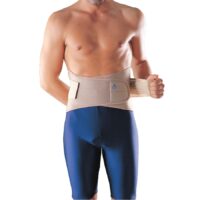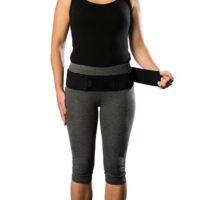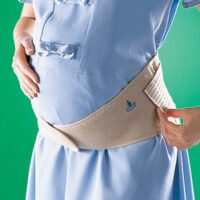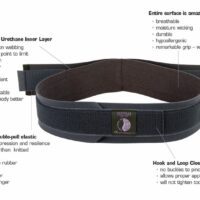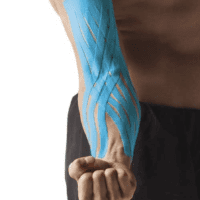Pregnancy Back Pain
Article by Zoe Russell

How To Manage Pregnancy Back Pain
The good news is, your baby is growing, which is what should be happening, but it can still be tough on your back. You’ve got lots of company – many pregnant women experience back pain, usually starting in the second half of pregnancy.
You should know that there are things you can do to minimise your back pain.
Causes Of Back Pain In Pregnant Women
Pregnancy back pain typically happens where the pelvis meets your spine, at the sacroiliac joint or SIJ, in the lumbar spine or at the joint between the two halves of the pelvic rim known as the pubic symphysis.
There are many possible reasons why it happens. Here are some of the more likely causes:
Hormone Changes
During pregnancy, your body makes a hormone called relaxin that allows ligaments in the pelvic area to relax and thus the joints to become looser in preparation for the birth process. The same hormone can cause ligaments that support the spine to loosen, leading to instability and pain, particularly if before pregnancy, you had some weakness of the muscles supporting this region.
Muscle Separation
As the uterus expands, two parallel sheets of muscles (the rectus abdominis muscles or six-pack muscles), which run from the rib cage to the pubic bone, may separate along the centre seam. This separation may worsen back pain.
Weight Gain
During a healthy pregnancy, women typically gain weight. The spine has to support that weight. That can cause lower back pain. The weight of the growing foetus and uterus also puts pressure on the blood vessels and nerves in the pelvis and back.
Posture Changes
Pregnancy shifts your centre of gravity. As a result, you may gradually – even without noticing – adjust your posture and the way you move. This postural change may result in back pain or strain.
Stress
Emotional stress can cause muscle tension in the back, expressing itself as back pain or back spasms. You may find that you experience an increase in back pain during stressful periods of your pregnancy.
Treatments For Back Pain In Pregnancy
There is good news! Unless you had chronic backaches before you got pregnant, your pain would likely ease gradually before giving birth.
Meanwhile, there are many things you can do to treat low back pain or make it rarer and milder:
Improve Your Posture
Slouching strains your spine. So using proper posture when working, sitting, or sleeping is a good move. For example, sleeping on your side with a pillow between the knees will take the stress off your back. When sitting at a desk, place a rolled-up towel behind your back for support; rest your feet on a stack of books or stool and sit up straight, with your shoulders back.
Wearing a support belt may also help. Your physiotherapist is the best person to advise you if this is likely to be beneficial for you.
Physiotherapy
Your physiotherapist is an expert when it comes to assessing and managing your pregnancy-related back pain. After a thorough assessment, there is a lot that physiotherapists can do to help you with your pregnancy-related back pain. In most cases, they can help you with improving your joint position and control.
Your physiotherapist will devise a specialised program tailored to your needs and the stage of your pregnancy.
Physiotherapy treatment may include any of the following, depending on your specific needs:
- Massage
- Joint Mobilisation
- Kinesio Taping
- Heat or Ice
- Joint mobility and stability exercises
- Posture education
- Pregnancy support prescription
- Yoga or pilates based exercises.
Exercise
Regular general exercise strengthens muscles and boosts flexibility – which may ease the stress on your spine.
Safe exercises for most pregnant women include:
- Walking
- Swimming
- Stationary Cycling
It is best to discuss your pre-pregnancy and current exercise regime with your physiotherapist, who can recommend the best exercises for your needs to strengthen your back and abdomen.
Maternity Belt
Some women benefit from a supportive maternity back brace specially designed for pregnant women. Ask your physiotherapist if one would be suitable for you.
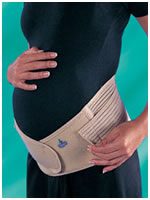
More details are available here: Maternity Belt
Heat and Cold
Applying heat and cold to your back may help. Be careful not to apply heat to your abdomen during pregnancy.
Exploring Common Sources of Buttock Pain and SIJ Issues
Discovering the origins of buttock pain and sacroiliac joint (SIJ) discomfort can be essential for effective management and relief. This article sheds light on various conditions that can contribute to such discomfort, encompassing joint injuries, muscle-related issues, nerve-related injuries, and bone-related concerns. By understanding the potential culprits behind buttock pain and SIJ troubles, you can take proactive steps towards addressing and alleviating these discomforts.
The following conditions may cause buttock pain or SIJ issues.
Joint Injuries
Pregnancy-Related Pain
Muscle-Related Injuries
- Piriformis Syndrome
- Poor Hip Core Control
- Core Stability Deficiency
- DOMS - Delayed Onset Muscle Soreness
Lateral Hip Pain
Nerve-Related Injuries
Bone-Related Injuries
- Osteoporosis
- Fractures
- Stress Fracture (Pelvis or Sacrum)
Introduction to Hip & Groin Pain
Hip and groin pain affects a wide array of individuals, from athletes to the elderly. Understanding the common causes and treatments of this pain is vital for maintaining overall well-being and mobility.
Common Causes of Hip Pain
- Hip Joint Pain: This includes conditions like hip osteoarthritis, where the hip joint undergoes wear and tear, leading to inflammation and pain.
- Hip Labral Tear: A tear in the ring of cartilage surrounding the hip joint socket, often causing sharp pain during movement.
- Femoroacetabular Impingement (FAI): An abnormal hip joint shape that can lead to labral tears and arthritis.
- Stress Fracture: Small cracks in the hip bone, often due to overuse.
- Avascular Necrosis: Loss of blood flow to the femoral head, leading to joint destruction.


Lateral Hip Pain and Its Causes
- Greater Trochanteric Pain Syndrome: Inflammation of the tissues surrounding the hip.
- Gluteal Tendinopathy: Inflammation or irritation of the gluteal tendons.
- Trochanteric Bursitis: Inflammation of the bursa near the hip joint.
Groin Pain: Different Types and Causes
- Adductor-Related Groin Pain: Injuries to the muscles on the inner thigh.
- Osteitis Pubis: Inflammation of the pubic symphysis, often seen in athletes.
- Iliopsoas-Related Groin Pain: Strain or injury to the hip flexor muscles.
Other Muscle-Related Pain
- Piriformis Syndrome: Compression of the sciatic nerve by the piriformis muscle.
- Muscle Strain: Overstretching or tearing of muscle fibres.
- Core Stability Deficiency: Weakness in the core muscles, affecting hip stability.
Systemic Diseases Affecting the Hip
- Osteoporosis: Bone weakening, increasing fracture risk.
- Rheumatoid Arthritis: An autoimmune disease causing joint inflammation.
- Fibromyalgia: Widespread muscle pain and tenderness.
Referred Pain Sources
- Sciatica: Pain radiating along the sciatic nerve, which runs from the lower back through the hips and down the legs.
- Lower Back Pain: Can refer pain to the hip area.
- Pinched Nerve: Nerve compression in the spine or hip area.
Hip Surgery: A Solution for Severe Cases
- Hip Replacement: A surgical option for severe hip arthritis or damage.
What's New in Hip & Groin Pain Research?
Recent studies suggest the importance of tailored exercise programs in managing hip and groin pain. Physiotherapy techniques focusing on strengthening and stabilising the deep hip rotators and core muscles have shown significant improvements in pain management and mobility.
What to Do? Seeking Professional Advice
If you're experiencing hip or groin pain, it's crucial to consult with a physiotherapist or doctor.
They can assess your condition, provide a personalised treatment plan, and guide you through exercises tailored to your specific needs.
Conclusion
Hip and groin pain can significantly impact your quality of life. However, with the right knowledge and professional guidance, managing and overcoming this pain is achievable.
Related Articles
- Groin Pain Management - Expert advice on managing groin pain, covering causes such as adductor tendinopathy and femoroacetabular impingement.
- Hip, Groin & Buttock Pain FAQs: Symptoms, Causes, Treatments - Answers to frequently asked questions about hip, groin, and buttock pain, including symptoms, causes, and treatments.
- Hip Labral Tear - Information on hip labral tears, their symptoms, and treatment options.
- Piriformis Syndrome - Understanding & Physio Treatment Tips - Insight into piriformis syndrome, a condition causing buttock pain and how physiotherapy can help.
- Trochanteric Bursitis - Hip Bursitis: Causes & Treatments - An article explaining the causes of hip bursitis and offering treatment solutions.
- Groin Strain - Discusses groin strains, their symptoms, causes, and treatment methods.
- Gluteal Tendinopathy: Causes, Symptoms, And Treatment - Offers insights into the causes and treatment of gluteal tendinopathy.




